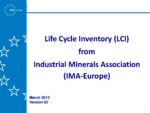Life Cycle Assessment
Background
Life Cycle Assessments (LCA) were developed over the last years as a tool enabling the identification and assessment of the environmental impacts associated with a product, process, or activity by quantifying raw materials, energy and waste it releases into the air, water and soil.
Why is it important?
In the case of Industrial Minerals Europe, the LCA covers the extraction, processing, manufacturing, distribution, use and disposal steps, including transportation, along the entire supply chain (i.e. upstream and downstream). It allows estimating the environmental impacts resulting from all stages in the product life cycle.
ISO 14040-14044 standards determine the generic framework for conducting an LCA. There are four main steps to be considered while conducting an LCA:
- Goal and scope definition;
- Life cycle inventory (LCI);
- Life cycle impact assessment;
- Life cycle interpretation.
Some of the leading environmental impacts investigated within an LCA are: greenhouse global warming potential, abiotic depletion, acidification, energy consumption, and water footprint.
LCA has become one of the main pillars driving European policy concerning sustainable use of resources, sustainable consumption and production, eco-labelling, eco-design, innovation, waste prevention and waste recycling, to mention just a few.
To provide stakeholders (e.g. authorities, customers) with European average representative environmental footprint values, IMA-Europe’s members have conducted and finalized multiple life cycle inventory (LCI) studies, following the ISO 14040-14044 standards ILCD and PEF requirements on multiple industrial minerals (see table). All minerals LCIs are from cradle to gate and all data from IMA-Europe and its different sections are published on the GaBi platform.

To request the mineral’s LCI, please feel free to contact: a.shtiza@ima-europe.eu
Links
- The European Commission – Joint Research Centre (JRC) has created a dedicated website for Life Cycle Thinking and Assessment.
- One of IMA-Europe’s members, the European Lime Association (EuLA), has developed an LCI (Life Cycle Inventory) for quicklime and hydrated lime. This extensive set of data covers the relevant energy and material inputs and environmental outputs at all stages of the lime production process.


